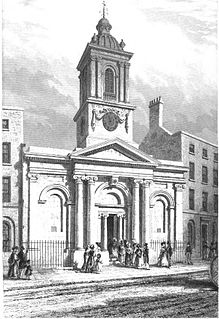 W
WThe Abbey of the Woods was a Bernardine convent in Paris, with buildings at 16 rue de Sèvres and at 11 rue de la Chaise in the 7th arrondissement. The buildings used by the convent were repurposed several times before their destruction in 1907.
 W
WExeter Hall was a hall on the north side of the Strand, London, England. From 1831 until 1907 Exeter Hall was the venue for much ameliorative by promoters of human betterment.
 W
WThe Great Wheel, also known as the Gigantic Wheel, or Graydon Wheel, was built for the Empire of India Exhibition at Earls Court, London, in the United Kingdom. Construction began in March 1894 at the works of Maudslay, Sons and Field in Greenwich and it opened to the public on 17 July 1895. Modelled on the original Ferris Wheel which featured at the 1893 World's Columbian Exposition in Chicago, US, it was 94 metres (308 ft) tall and 82.3 metres (270 ft) in diameter. and weighed about 900 tons. It stayed in service until 1906, by which time its 40 cars had carried over 2.5 million passengers. It was demolished in 1907 following its last use with the Imperial Austrian Exhibition of 1906 as it was no longer profitable to run.
 W
WThe parish of St. John's Episcopal Church, Hartford, Connecticut, was formed in 1841. Its first building, designed by Henry Austin (architect), was constructed on Main Street just south of the Wadsworth Atheneum in 1842. The parish left Hartford in 1907 and is now St. John's Episcopal Church.
 W
WSt Peter le Poer was a parish church on the west side of Broad Street in the City of London. Of medieval origin, it was rebuilt in 1540, and again in 1792 to a design by Jesse Gibson with a circular nave. It was demolished in 1907.
 W
WSt. Louis Exposition and Music Hall was an indoor exposition hall, Music Hall and arena in St. Louis, Missouri from 1883 to 1907.
 W
WWatkin's Tower was a partially completed iron lattice tower in Wembley Park, London, England. Its construction was an ambitious project to create a 358-metre (1,175 ft)-high visitor attraction in Wembley Park to the north of the city, led by the railway entrepreneur Sir Edward Watkin. Marketed as the "Great Tower of London", it was designed to surpass the height of the Eiffel Tower in Paris, and it was part of Wembley Park's emergence as a recreational place. The tower was never completed and it was demolished in 1907. The site of the tower is now occupied by the English national football ground, Wembley Stadium.